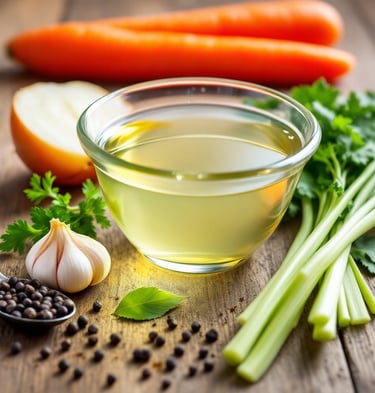Vegetable Stock
Vegetable stock, like other stocks, is believed to have originated in France as part of the foundation of French cuisine.
VEGETARIANEASY TO MAKESAVORY COOKING LIQUID
Lourdes Rodriguez
3/13/20256 min read


Origin of Vegetable Stock
Vegetable stock, like other stocks, is believed to have originated in France as part of the foundation of French cuisine. Historically, stocks were made from bones and meat, but vegetable-based stocks have been in use for centuries, especially in vegetarian and vegan traditions. The practice of making vegetable stock is part of the broader tradition of using scraps and leftovers to create flavorful broths and soups, an early form of waste reduction and sustainable cooking.
Vegetable stock has gained significant popularity, especially within vegetarian, vegan, and health-conscious cooking communities, as it serves as a versatile and flavorful base for a wide range of dishes, all while being completely free of animal products. Additionally, vegetable stock stands out for its simplicity and speed, making it one of the quickest and easiest stocks to prepare.
Health Benefits of Vegetable Stock
Low in Calories and Fat: Vegetable stock is typically low in calories and contains very little fat, making it a good option for people on calorie-controlled diets.
Packed with Nutrients: The vegetables and herbs used in making vegetable stock contribute vitamins and minerals such as vitamin C, potassium, folate, and antioxidants.
Hydration: Because stock is mostly water, it can help keep you hydrated while adding minimal calories.
Supports Digestive Health: The soluble fiber from vegetables can be released into the stock, which may help with digestion and gut health.
No Additives or Preservatives: Homemade vegetable stock is free from preservatives and artificial flavorings, making it a healthier option than many store-bought versions.
Tips for Making Vegetable Stock
Use Fresh Ingredients: The fresher the vegetables, the more flavor you will extract. You can use vegetable scraps (like onion skins, carrot ends, or celery leaves) to save on waste.
Add Umami: To enhance the depth of flavor, consider adding a small piece of dried seaweed (like kombu) or a couple of dried mushrooms (shiitake or porcini) during the simmering process.
Do not Overcrowd the Pot: Make sure there is enough water to cover all the vegetables. If you are making a large batch, it is better to split it into two pots than to overcrowd.
Simmer, Don't Boil: Bring the stock to a boil, but then reduce the heat to a simmer. Boiling can result in a cloudy, bitter stock. Simmering gently will give you a clearer, more flavorful stock.
Strain Well: Straining your stock through a fine-mesh sieve or cheesecloth will ensure that the stock remains clear and smooth.
Customize Your Flavor: You can tweak the recipe based on the type of dish you are making. For example, adding more herbs for a hearty stew or a touch of citrus zest for a light soup.
Good Reasons to Make Your Own Vegetable Stock:
Control Over Ingredients: Making your own vegetable stock means you can control the ingredients and avoid unnecessary sodium, artificial flavors, and preservatives often found in store-bought versions.
Cost-Effective: If you use vegetable scraps and leftovers, you can make vegetable stock at little to no additional cost.
Better Taste: Homemade stock is often far more flavorful than store-bought versions because you are using fresh, whole ingredients.
Flexibility: You can adjust the flavor profile to match your specific needs and dietary preferences, something you cannot do with pre-made stock.
Eco-Friendly: Making your own stock from vegetable scraps reduces food waste, helping both your wallet and the planet.
Vegetable Stock Recipe
Serving: 2qt.
Ingredients:
2 large onions, peeled and quarter
4 carrots, peeled and roughly chopped
½ head of celery, cut into chunks
4-8 cloves garlic, peeled and slightly smashed
3-4 sprigs fresh thyme (1 tsp. dried thyme)
1 small bouquet of parsley
1 tsp. black peppercorns
2 bay leaves
2 quarts water
1 leek washed and cut into chunks, (optional)
1/4 cup sun-dried tomato, (optional)
Instructions:
Add vegetables, herbs and water: Add the vegetables along with the herbs, peppercorns, and water. Bring it to a boil over high heat, then reduce the heat and let it simmer gently for about 45 minutes to 1 hour.
Strain the stock: Once the vegetables have released their flavors, strain the stock through a fine mesh sieve or cheesecloth to remove the solids.
Cool and store: Taste your stock and add salt if desired. Allow the stock to cool completely before transferring it to containers. Store in the refrigerator for up to 5 days or freeze for longer storage.
Note:
For a darker broth: Heat olive oil in a large pot over medium heat. Add the vegetables and garlic. Sauté for about 5 minutes until they begin to soften and release their aromas. Then, continue with the previous instructions.
Sodium Control: If you add too much salt to your stock from the beginning, it can be difficult to control the amount of salt at the end of the dishes you cook with that broth. It is best to add salt to taste later, while preparing the final dish, to prevent the stock from becoming too salty. Reducing the amount of salt in your stock is also a healthier option, especially if you are looking to keep sodium levels in your diet low.
To enhance or customize the flavor profile of your vegetable stock, consider adding different herbs based on the dish you are preparing. For example:
For a light, fresh flavor: Add parsley and dill for a bright, herbaceous taste, perfect for light soups or seafood-based dishes.
For a savory, earthy depth: Try adding thyme and rosemary, which complement hearty stews and roasted vegetables.
For a warm, comforting base: Use sage and bay leaves, ideal for autumnal dishes like squash soups or risottos.
For a more aromatic, spiced stock: Incorporate coriander seeds or cumin to add an exotic touch, perfect for curries and Middle Eastern dishes.
For a Mediterranean flair: Add oregano and basil, which are great for Italian-inspired dishes like pasta sauces or vegetable casseroles.
For a Latin-inspired flavor: Add cilantro, culantro (recao) or oregano to enhance the flavor profile of soups, stews, or rice dishes.
Feel free to experiment with these herbs, or combine them to suit your specific needs—herbs can really elevate the stock and give it a distinctive, personalized flavor.
Homemade vegetable stock typically lasts:
In the refrigerator: 3 to 5 days
In the freezer: 3 to 4 months
For best results, allow the stock to cool completely before storing it. You can store it in airtight containers or freezer bags. If you're freezing the stock, make sure to leave some space in the container for expansion as the liquid freezes.
Risk of Food Poisoning from Homemade Stock
There can be a risk of foodborne illness or food poisoning if homemade stock is not stored or handled properly. Here are some key tips to reduce that risk:
1. Cool the Stock Quickly:
Avoid leaving stock out at room temperature for too long (more than 2 hours). Bacteria can multiply rapidly in warm liquid. To cool the stock quickly, you can divide it into smaller containers or use an ice bath (placing the container in a larger bowl filled with ice and water) to bring the temperature down faster.
2. Refrigerate Promptly:
Store stock in the refrigerator as soon as possible after it has cooled. Keep it at a temperature of 40°F (4°C) or below. If the stock is left in the "danger zone" (between 40°F and 140°F) for more than a couple of hours, bacteria like Salmonella and E. coli could begin to grow.
3. Reheat Properly:
When reheating homemade stock, make sure to bring it to a rolling boil to kill any bacteria that may have developed during storage. Avoid reheating stock multiple times, as repeated temperature fluctuations can increase the risk of bacterial growth.
4. Check for Signs of Spoilage:
Look, smell, and taste before using: If the stock looks cloudy, has an off-smell, or has mold growing on the surface, discard it. Do not take risks with food that might be spoiled.
5. Use Clean Containers:
Always store your stock in clean, airtight containers to prevent contamination. If you are freezing it, make sure the containers are freezer-safe and sealed tightly.
By following these guidelines, the risk of foodborne illness is minimal, and you can safely enjoy your homemade stock!
Reasons why you might want to avoid vegetable stock:
Food Allergies or Sensitivities: If you are allergic to any ingredients used in vegetable stock (such as certain vegetables or herbs), you may need to avoid it. For example, some people have sensitivities to nightshade vegetables like tomatoes, peppers, or eggplant, which can sometimes be used in stocks.
Specific Dietary Restrictions: Certain vegetable stocks may not be suitable for all diets. For example, if you are following a low-sodium or no-salt diet, store-bought versions may contain high amounts of sodium, which would make them unsuitable for your needs.
Flavor Preferences: Some individuals may not like the taste of vegetable stock or prefer broths with a stronger, meat-based flavor.
Vegan or Vegetarian Considerations: If a vegetable stock is made with ingredients that are not in line with your specific dietary practices (e.g., using animal-based ingredients like gelatin), it may not be suitable.
Digestive Issues: In rare cases, certain ingredients in vegetable stock may irritate the digestive system, such as garlic or onions, which could be problematic for individuals with irritable bowel syndrome (IBS) or other digestive disorders.
Important: If you have any doubts about incorporating this food into your diet, it is always a good idea to consult with your dietician or doctor.
Plenitaste
Inspiring healthy, global recipes for everyone.
contact me:
Recipe
plenitaste@gmail.com
© 2025. All rights reserved.
